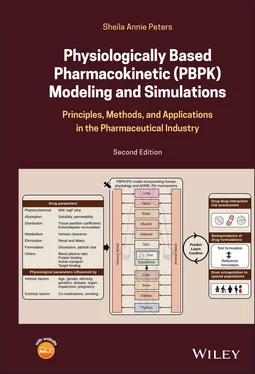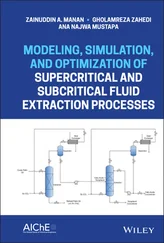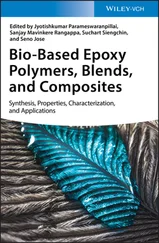1 Ahn, S.Y. and Nigam, S.K. (2009). Toward a systems level understanding of organic anion and other multispecific drug transporters: a remote sensing and signaling hypothesis. Mol Pharmacol 76 (3): 481–490. https://doi.org/10.1124/mol.109.056564.
2 Benet, L.Z. (2009). The drug transporter‐metabolism alliance: uncovering and defining the interplay. Mol Pharm 6 (6): 1631–1643. https://doi.org/10.1021/mp900253n.
3 Benet, L.Z. and Hoener, B.A. (2002). Changes in plasma protein binding have little clinical relevance. Clin Pharmacol Ther 71 (3): 115–121. https://doi.org/10.1067/mcp.2002.121829.
4 Colburn, W.A. and Keefe, D.L. (2003). Biomarkers in drug discovery and development: from target identification through drug marketing. J Clin Pharmacol 43 (4): 329–341. https://doi.org/10.1177/0091270003252480.
5 Colburn, W.A. and Lee, J.W. (2003). Biomarkers, validation and pharmacokinetic‐pharmacodynamic modelling. Clin Pharmacokinet 42 (12): 997–1022. https://doi.org/10.2165/00003088‐200342120‐00001.
6 Danhof, M., Alvan, G., Dahl, S.G. et al. (2005). Mechanism‐based pharmacokinetic‐pharmacodynamic modeling ‐ a new classification of biomarkers. Pharm Res 22 (9): 1432–1437. https://doi.org/10.1007/s11095‐005‐5882‐3.
7 Dresser, M.J., Leabman, M.K., and Giacomini, K.M. (2001). Transporters involved in the elimination of drugs in the kidney: organic anion transporters and organic cation transporters. J Pharm Sci 90 (4): 397–421. https://doi.org/10.1002/1520‐6017(200104)90:4<397::AID‐JPS1000>3.0.CO;2‐D.
8 Duan, P. and You, G. (2010). Short‐term regulation of organic anion transporters. Pharmacol Ther 125 (1): 55–61. https://doi.org/10.1016/j.pharmthera.2009.08.002.
9 El‐Sheikh, A.A.K., Masereeuw, R., and Russel, F.G.M. (2008). Mechanisms of renal anionic drug transport. Eur J Pharmacol 585 (2–3): 245–255. https://doi.org/10.1016/j.ejphar.2008.02.085.
10 Fredriksson, R., Nordström, K.J., Stephansson, O. et al. (2008). The solute carrier (SLC) complement of the human genome: phylogenetic classification reveals four major families. FEBS Lett 582 (27): 3811–3816. https://doi.org/10.1016/j.febslet.2008.10.016.
11 Van Der Graaf, P.H., Van Schaick, E.A., Math‐ot, R.A. et al. (1997). Mechanism‐based pharmacokinetic‐pharmacodynamic modeling of the effects of N6‐oyclopentyladenosine analogs on heart rate in rat: estimation of in vivo operational affinity and efficacy at adenosine A1 receptors. J Pharmacol Exp Ther 283 (2): 809–816.
12 Hagenbuch, B. and Gui, C. (2008). Xenobiotic transporters of the human organic anion transporting polypeptides (OATP) family. Xenobiotica 38 (7–8): 465–801. https://doi.org/10.1080/00498250801986951.
13 Hediger, M.A., Romero, M.F., Peng, J. et al. (2004). The ABCs of solute carriers: physiological, pathological and therapeutic implications of human membrane transport proteins. Arch Eur J Physiol 447 (5): 465–468. https://doi.org/10.1007/s00424‐003‐1192‐y.
14 Hinderling, P.H. (1997). Red blood cells: a neglected compartment in pharmacokinetics and pharmacodynamics. Pharmacol Rev 49 (3): 279–295.
15 Ho, R.H. and Kim, R.B. (2005). Transporters and drug therapy: implications for drug disposition and disease. Clin Pharmacol Ther 78 (3): 260–277. https://doi.org/10.1016/j.clpt.2005.05.011.
16 Jusko, W.J., Piekoszewski, W., Klintmalm, G.B. et al. (1995). Pharmacokinetics of tacrolimus in liver transplant patients. Clin Pharmacol Ther 57 (3): 281–290. https://doi.org/10.1016/0009‐9236(95)90153‐1.
17 Kusuhara, H. and Sugiyama, Y. (2009). In vitro‐in vivo extrapolation of transporter‐mediated clearance in the liver and kidney. Drug Metab Pharmacokinet 24 (1): 37–52. https://doi.org/10.2133/dmpk.24.37.
18 Lesko, L. and Atkinson, A.J. (2001). Use of biomarkers and surrogate endpoints in drug development and regulatory decision making: criteria, validation, strategies. Annu Rev Pharmacol Toxicol 41: 347–366.
19 Ludden, T.M. (1991). Nonlinear pharmacokinetics: clinical implications. Clin Pharmacokinet 20 (6): 429–446. https://doi.org/10.2165/00003088‐199120060‐00001.
20 Mager, D.E., Woo, S., and Jusko, W.J. (2009). Scaling pharmacodynamics from in vitro and preclinical animal studies to humans. Drug Metab Pharmacokinet 24 (1): 16–24. https://doi.org/10.2133/dmpk.24.16.
21 Masereeuw, R. and Russel, F.G.M. (2010). Therapeutic implications of renal anionic drug transporters. Pharmacol Ther 126 (2): 200–216. https://doi.org/10.1016/j.pharmthera.2010.02.007.
22 Nies, A.T., Schwab, M., and Keppler, D. (2008). Interplay of conjugating enzymes with OATP uptake transporters and ABCC/MRP efflux pumps in the elimination of drugs. Expert Opin Drug Metab Toxicol 4 (5): 545–568. https://doi.org/10.1517/17425255.4.5.545.
23 Nordström, A.L., Farde, L., Wiesel, F. et al. (1993). Central D2‐dopamine receptor occupancy in relation to antipsychotic drug effects: a double‐blind PET study of schizophrenic patients. Biol Psychiatry 33 (4): 227–235. https://doi.org/10.1016/0006‐3223(93)90288‐O.
24 Paixão, P., Gouveia, L.F., and Morais, J.A.G. (2009). Prediction of drug distribution within blood. Eur J Pharm Sci 36 (4–5): 544–554. https://doi.org/10.1016/j.ejps.2008.12.011.
25 Peck, C.C., Rubin, D.B., and Sheiner, L.B. (2003). Hypothesis: a single clinical trial plus causal evidence of effectiveness is sufficient for drug approval. Clin Pharmacol Ther 73 (6): 481–490. https://doi.org/10.1016/S0009‐9236(03)00018‐3.
26 Schinkel, A.H. and Jonker, J.W. (2012). Mammalian drug efflux transporters of the ATP binding cassette (ABC) family: an overview. Adv Drug Del Rev 64 (SUPPL): 138–153. https://doi.org/10.1016/j.addr.2012.09.027.
27 Shah, K., Gupta, J.K., Chauhan, N.S. et al. (2017). Prodrugs of NSAIDs: a review. Open Med Chem J https://doi.org/10.2174/1874104501711010146.
28 Shen, S. and Zhang, W. (2010). ABC transporters and drug efflux at the blood‐brain barrier. Rev Neurosci 21 (1): 29–53. https://doi.org/10.1515/REVNEURO.2010.21.1.29.
29 Sieghart, W. (1994). Pharmacology of benzodiazepine receptors: an update. J Psychiatry Neurosci 19 (1): 24–29.
30 Singh, S. (2006). Preclinical pharmacokinetics: an approach towards safer and efficacious drugs. Curr Drug Metab 7 (2): 165–182. https://doi.org/10.2174/138920006775541552.
31 Szakács, G., Váradi, A., Özvegy‐Laczka, C. et al. (2008). The role of ABC transporters in drug absorption, distribution, metabolism, excretion and toxicity (ADME‐Tox). Drug Discov Today https://doi.org/10.1016/j.drudis.2007.12.010.
32 Uchimura, T., Kato, M., Saito, T. et al. (2010). Prediction of human blood‐to‐plasma drug concentration ratio. Biopharm Drug Dispos 31 (5–6): 286–297. https://doi.org/10.1002/bdd.711.
33 Varma, M.V.S. et al. (2009). Physicochemical determinants of human renal clearance. J Med Chem 52 (15): 4844–4852. https://doi.org/10.1021/jm900403j.
34 Van De Water, F.M., Masereeuw, R., and Russel, F.G.M. (2005). Function and regulation of multidrug resistance proteins (MRPs) in the renal elimination of organic anions. Drug Metab Rev 37 (3): 443–471. https://doi.org/10.1080/03602530500205275.
35 Wright, J.D., Boudinot, F.D., and Ujhelyi, M.R. (1996). Measurement and analysis of unbound drug concentrations. Clin Pharmacokinet 30 (6): 445–462. https://doi.org/10.2165/00003088‐199630060‐00003.
36 Wright, S.H. and Dantzler, W.H. (2004). Molecular and cellular physiology of renal organic cation and anion transport. Physiol Rev 84 (3): 987–1049. https://doi.org/10.1152/physrev.00040.2003.
37 Zhang, E.Y., Knipp, G.T., Ekins, S. et al. (2002). Structural biology and function of solute transporters: implications for identifying and designing substrates. Drug Metab Rev 34 (4): 709–750. https://doi.org/10.1081/DMR‐120015692.
Читать дальше












